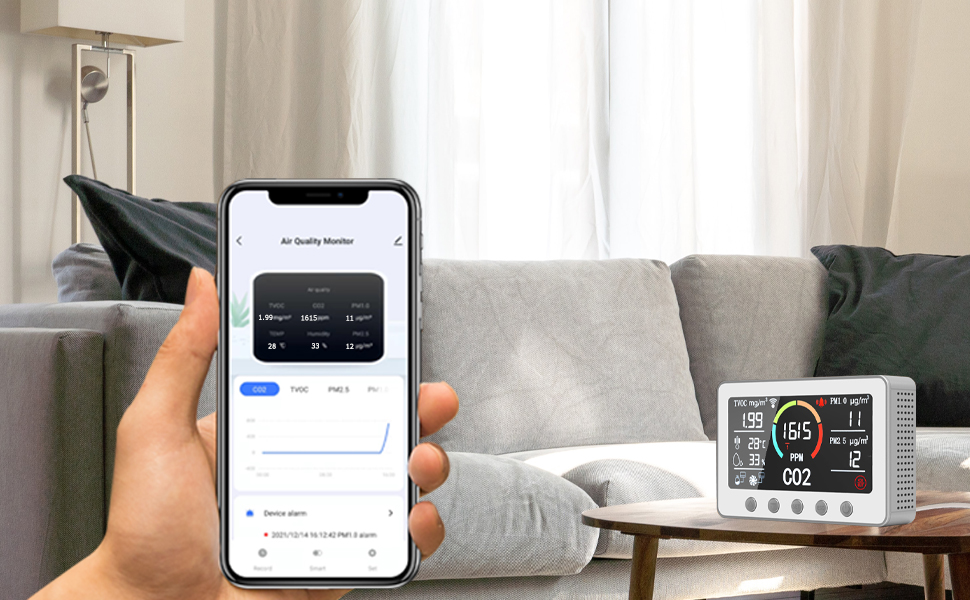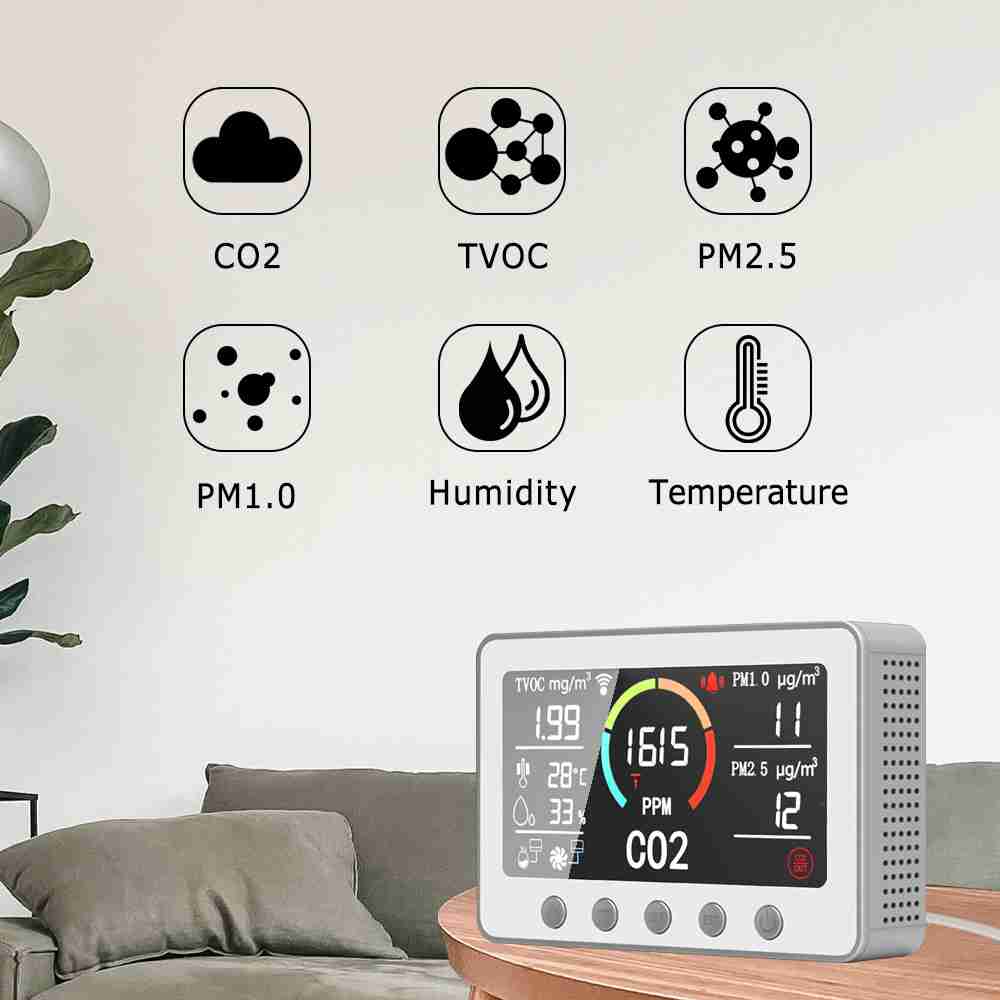
The air we breathe has a significant impact on our overall health and happiness. And, because many of us spend the majority of our time indoors, even if just sleeping, it’s critical to do everything we can to keep indoor air quality high (IAQ).
This involves keeping our oxygen levels high and our carbon dioxide levels low, as well as maintaining a comfortable temperature and humidity. But it also involves using a good monitoring gadget to keep an eye on dangerous contaminants in the air. For example, volatile organic compounds, which are found in a wide range of products from cleaners and solvents to gas grills and cigarettes, can have a significant impact on indoor air quality, and high quantities can cause major health problems.
Limiting exposure begins with being aware. However, because these chemicals are so prevalent, it’s difficult to totally avoid them. Use a smart indoor air quality detector is essential for monitoring indoor air quality.
The Importance of Indoor Air Quality (IAQ)
Anyone who has traveled out of a congested metropolis into the country knows how much air quality can alter one’s quality of life. These surroundings make it simpler to breathe, sleep, and recharge. However, the positive impacts of strong IAQ go beyond simply feeling better; it is an effective way of preventing certain short- and long-term health problems.
Poor air quality, for example, can lead to:
- Irritation of the eyes and respiratory tract
- Headaches
- Dizziness
- Visual disorders and memory impairment.
Repeated exposure to high levels of volatile organic compounds, nitrogen oxides, and other hazardous substances, on the other hand, can have substantial long-term health consequences, including:
- Frequent headaches and loss of coordination.
- Persistent nausea
- Chronic eye, nose and throat irritation
- Liver, kidney and central nervous system damage
- Some types of cancer.
As a result, maintaining excellent IAQ is more than a comfort issue. If ignored, it might become a matter of life and death over time.
Improving Indoor Air Quality
While there is no substitute for fresh air, you may take steps to ensure that the air within your home is as good as it can be.
To reach to this stage, the first step is to assess your home’s present indoor air quality. Start by learning how to assess volatile organics and other dangerous compounds, and then look into purchasing a smart IAQ detector.
If an issue is discovered, take the following steps:
- Determine which chemical(s) and their source are deteriorating your air quality. Remove any items that emit a lot of VOCs or other pollutants.
- Make sure your home has adequate ventilation.
- If you live in a dry climate, install humidifiers throughout your home. Humid air is simpler to breathe and is healthy for the lungs.
- Off-gassing is a process that involves temperature and humidity. In other words, the higher the temperature, the more some products will emit high levels of VOCs. Because you probably don’t want to drop your temperature too much, the best alternative is to start with low-VOC materials, such as furniture.
- If difficulties persist, contact an HVAC professional for assistance, as there may be a more substantial source of dangerous substances that is not readily apparent.
Choosing an IAQ Monitor
Assessing the current situation is the first step in improving indoor air quality. Airborne contaminants are nearly impossible to detect on your own. To assist you, you’ll need a high-tech detector.
Here are some characteristics to look for in an effective IAQ detector:
- The ability to count particles. There will always be dust present. And while some dust isn’t inherently harmful, too many particles in the air can impair breathing and cause other major problems. Make that any air quality monitor includes a fine particle (PM) detection with a size of 2.5 microns or less.
- Detection of VOCs. These dangerous substances are everywhere, and they have a distinct odor. VOCs can be found in fresh paint, air fresheners, paint thinners, and even laundry detergents. Make sure your IAQ detector can detect and inform you when certain chemicals’ concentrations reach dangerous levels.
The EPA’s list of VOCs can be found here. Carbon monoxide and dioxide, which are mentioned below, are not considered VOCs.
Carbon monoxide (CO). Carbon monoxide poisoning can kill you in minutes, so be sure you have a detector that can detect it when it’s there.
- CO2 (carbon dioxide) (CO2) While it isn’t a pollutant, it is worth monitoring because high amounts of carbon dioxide usually imply low levels of oxygen, which might be problematic. Surprisingly, health concerns linked to carbon dioxide exposure are frequently the result of excessive VOC levels, which are commonly linked to CO2.
Accuracy Is Important
When it comes to a home IAQ monitor, precision is crucial. However, in the past, getting the most accurate reading required thousands of dollars. Cheaper options were frequently inaccurate.
While a difference of one or two microns may not seem like a huge thing, large differences in measured vs actual IAQ might cause you to be over-exposed to harmful chemicals or particles, putting you at an unnecessary risk of getting health disorders related by poor air quality.
The Importance of Networking
We are living in the smart home era. Technology has made it easier than ever to understand and remedy air quality issues, and it has also brought some attractive alternative options for home air quality systems. Air quality monitors, for example, can be used to regulate humidifiers, purifiers, air conditioners, fans, and a variety of other devices in your house.
The best indoor air quality monitors will have a mobile app and a web app that can update you constantly about the status of your indoor air. And if you connect this to your smart home device, such as Tuya Smart, then you can automatically adjust your devices to help maintain good IAQ and improve it when there is an excessive amount of harmful chemicals in the air. Or you can even voice-control it through devices like Amazon Alexa.
Obtain Your Indoor Air Quality Detector

A smart indoor air quality monitor will improve your quality of life while also making you healthier. You won’t have to worry about pollutants in the air, and you can program your various systems to adjust when the air quality is poor. Because new technology has made these devices more affordable and effective than ever before, now is the time to get one and ensure that you always have good-quality air in your house.
GZAIR PT02 smart air quality monitor is useful for identifying air quality and allowing you to take action before things get too critical. Tuya Smart APP, works with PT02 to make it easier to monitor the air quality in your house. And it is smart enough. You can let it turn on fans, humidifiers, and ventilation systems automatically whenever IAQ measurements reach a certain level.

Leave A Comment